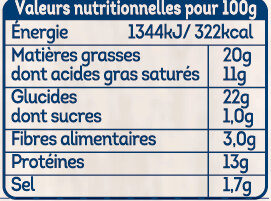Cheezy croc au Comté fondu - Père Dodu - 200 g - X2
This product page is not complete. You can help to complete it by editing it and adding more data from the photos we have, or by taking more photos using the app for Android or iPhone/iPad. Thank you!
×
Some of the data for this product has been provided directly by the manufacturer pere-dodu.
Barcode: 3596690272034 (EAN / EAN-13)
Common name: Comté fondu 60% enrobé d'une chapelure frite 40%.
Quantity: 200 g - X2
Brands: Père Dodu
Categories: Breaded products, fr:Croques Panés
Labels, certifications, awards: No colorings, No flavour enhancer, No palm oil, Nutriscore, Nutriscore Grade D
Origin of ingredients: European Union
Manufacturing or processing places: Galliance Elaborés BP24 LA VRAIE CROIX 56250 ELVEN
Traceability code: FR 56.261.001 CE - Vraie-Croix (Morbihan, France)
Stores: Cora
Countries where sold: France
Matching with your preferences
Environment
Packaging
Transportation
Report a problem
Data sources
Product added on by tacite
Last edit of product page on by packbot.
Product page also edited by org-pere-dodu, roboto-app, tacite-mass-editor, yuka.P5xGG4K1IJMrGPH-8pAywyjrPse-U6ZjPC4IoQ.











